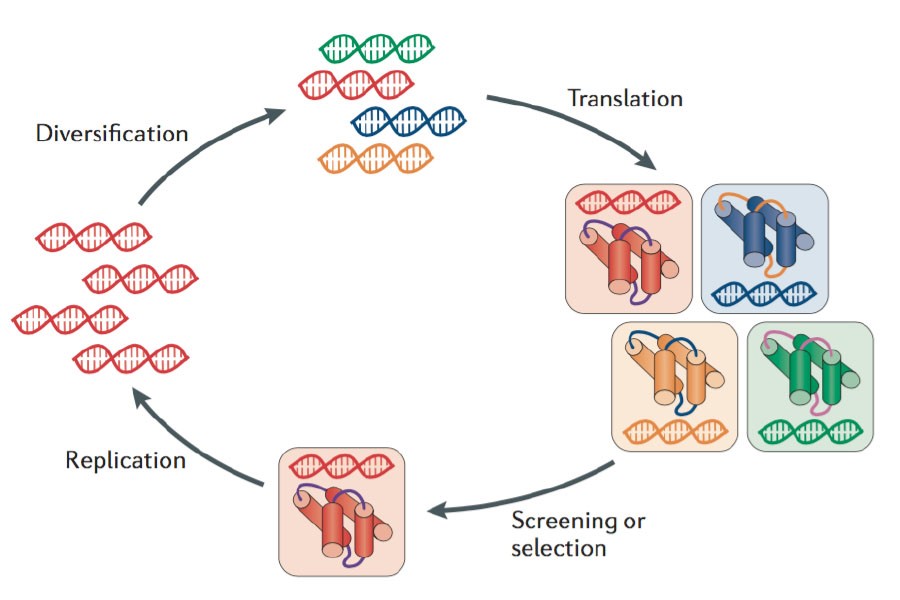Custom Mutagenesis Services
Creative Biostructure has rich professional experience in providing advanced custom mutagenesis and mutant libraries services. We have strong expertise in mutant libraries construction, and enable to synthesize rationally-designed or systematic mutant libraries as individually-sequenced clones using in vitro molecular optimization method.
Mutagenesis technology is the most popular method used to modify or optimize genes, which is also a powerful tool to study gene sequences and analyse the relationship between protein structures and functions. Mutagenesis technology representing protein variants is widely used to identify structurally and functioanlly crucial residues and to optimize protein functions. Creative Biostructure provides mutagenesis services for screening mutant libraries that have enhanced expression levels, solubility, stability, enzymatic activity, or interaction with desired binding partners.
 Figure 1. The process of a diverse library of genes construction
Figure 1. The process of a diverse library of genes construction
Creative Biostructure’s first-class custom mutagenesis services include but not limited to:
Creative Biostructure is able to use molecular biology methods to build sequence site-directed mutagenesis library to proivde an outstanding site-directed mutagenesis library construction service. For customers, it is very simple to conduct systematic research on protein characteristics, gene regulation and functions.
Site-saturation mutagenesis technology, which also termed site-directed random mutagenesis or targeted random mutagenesis, can mutate either single or multiple sites. Notably, site-saturation mutagenesis in combination with a powerful screening assay is the most systematic mutation strategy to identify amino acid substitutions that fulfill customers’ protein engineering goals.
Scanning point mutation is actually a systematic method of probing protein properties. It outperforms standard alanine/cysteine scanning by replacing each amino acid with all 20 amino acids simultaneously. This technique provides a detailed profile of each amino acid at the position. Besides, Creative Biostructure also provides alanine scanning services to rapidly identify amino acid residues critical for protein function, stability and shape.
Creative Biostructure can provide any form of randomization of the full-length gene in a synthetic DNA fragmen using error-prone PCR (epPCR) or sequence saturation mutagenesis (SeSaM).
Degenerated libraries designed by Creative Biostructure can allow researchers to focus gene diversity to the active site or interface positions.
Creative Biostructure can provide customers excellent truncation libraries (truncation variant libraries), which serve as powerful tools for structural biologists to identify minimal stable domains for crystallization and to identify border residues that are crucial protein function. Genes can be truncated from both the 5' and the 3' ends simultaneously to produce an incremental truncation library.
Nowadays, combinatorial assembly libraries becom a preferred recombinant mutagenesis strategy to build a diverse set of larger constructs. Creative Biostructure can combine predefined DNA parts (e.g., promoters, ribosomal binding sites, UTRs, open reading frames, signal peptides terminators, etc.) to form gene diversification.
Creative Biostructure is capable of creating gene diversification by gene recombination. Our scientists perform various different mutagenesis strategies (DNA shuffling, StEP, RACHITT, SCOPE, etc.) based on recombining properties coded in similar genes.
Creative Biostructure holds a set of algorithms in providing superior enhancement of protein expression compared to heterologously-expressed native sequences.
Please feel free to contact us for a detailed quote.
Ordering Process
References:
- C. Pal, et al. (2006). An integrated view of protein evolution. Nature reviews. Genetics, 7: 337-348.
- M. S. Packer and D. R. Liu (2015). Methods for the directed evolution of proteins. Nature reviews. Genetics, 16: 379-394.
- T. M. Jacobs, et al. (2014). SwiftLib: rapid degenerate-codon-library optimization through dynamic programming. Nucleic Acids Res., 43(5): e34.

